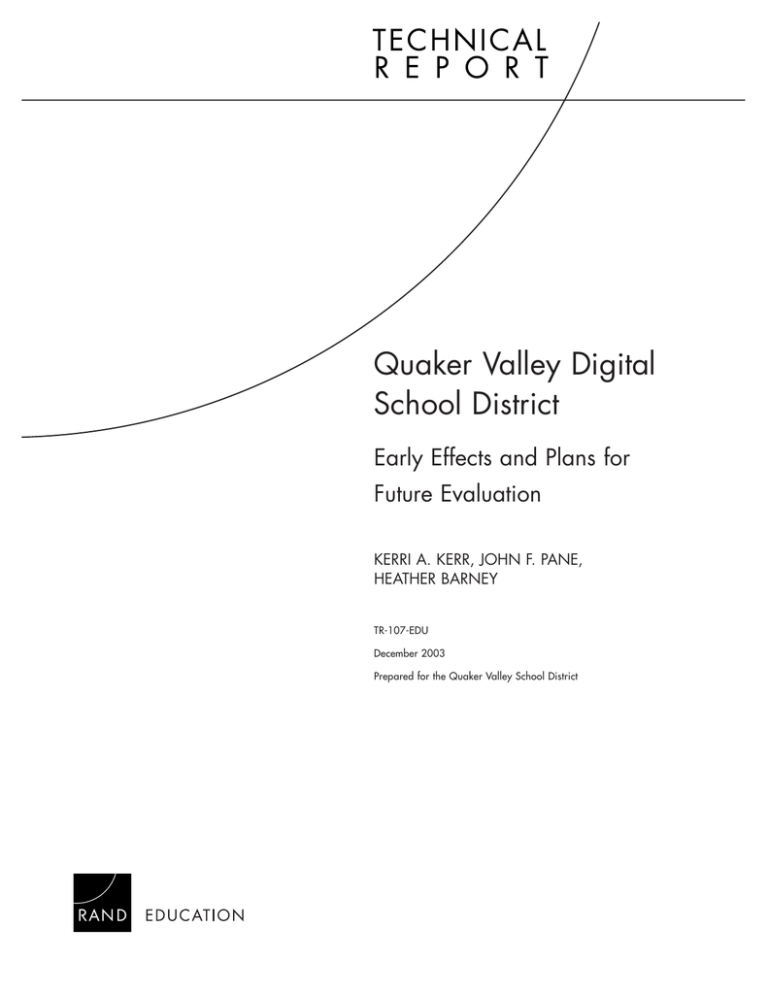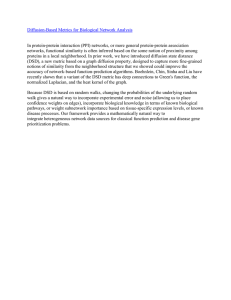
Quaker Valley Digital
School District
Early Effects and Plans for
Future Evaluation
KERRI A. KERR, JOHN F. PANE,
HEATHER BARNEY
TR-107-EDU
December 2003
Prepared for the Quaker Valley School District
The research described in this report was supported by the Quaker Valley School
District. The research was conducted in RAND Education.
ISBN: 0-8330-3538-X
The RAND Corporation is a nonprofit research organization providing objective analysis
and effective solutions that address the challenges facing the public and private sectors
around the world. RAND’s publications do not necessarily reflect the opinions of its research
clients and sponsors.
R® is a registered trademark.
© Copyright 2003 RAND Corporation
All rights reserved. No part of this book may be reproduced in any form by any electronic or
mechanical means (including photocopying, recording, or information storage and retrieval)
without permission in writing from RAND.
Published 2003 by the RAND Corporation
1700 Main Street, P.O. Box 2138, Santa Monica, CA 90407-2138
1200 South Hayes Street, Arlington, VA 22202-5050
201 North Craig Street, Suite 202, Pittsburgh, PA 15213-1516
RAND URL: http://www.rand.org/
To order RAND documents or to obtain additional information, contact
Distribution Services: Telephone: (310) 451-7002;
Fax: (310) 451-6915; Email: order@rand.org
SUMMARY
BACKGROUND AND PURPOSE
The Quaker Valley School District is one of three districts selected by the
Pennsylvania Department of Education to receive a two-year “Digital
School District” grant beginning in 2001. Key technology provisions in
Quaker Valley’s proposal were to supply laptop computers to every
student in grades 3–12, to set up wireless networks in all district buildings
and several community sites, and to provide wireless Internet connections
in the homes of all students in grades 3–12.
The purpose of this report is twofold. First, we provide a limited
evaluation of the implementation and impacts of the Digital School District
(DSD) program at the end of the grant period, based on data previously
collected by the district and its formative evaluator as well as limited
qualitative data collection by RAND during a 3-day site visit. Second, we
provide a conceptual framework and Theory of Change describing the
Quaker Valley program, and a research design for a future, more
comprehensive evaluation of the initiative.
FINDINGS
Reports from teachers and students, as well as classroom observations,
revealed wide variation in the use of technology across classrooms, both
because the technology is more applicable in some subject areas than in
others, and also due to variances among teachers’ comfort and aptitude
with the technology. Overall, teachers and students reported competency
in several basic software applications after the first year of the grant, and
additional competencies after the second year. The laptops engendered
some changes in the classroom by acting as a tool for performing functions
that were previously done by hand, such as recording attendance and
grades, taking notes, and conducting research. However, teachers reported
several factors that seemed to hinder the integration of technology into the
curriculum. In particular, they expressed the need for additional
professional development and technical support to facilitate curricular
integration.
xi
Contrary to an expectation that teachers would have more free time for
instruction, teachers reported increased clerical and management demands
on their time since the implementation of the DSD program. In addition,
teachers who put efforts into developing lessons to utilize the technology
found this required a large time commitment, with little formal support
from the district. Furthermore, because some students would inevitably
come to class without computers, many teachers were required to plan
alternate activities that could be performed without the computer, adding
to teacher workloads. One promising finding was that teachers were
taking advantage of a newly implemented online assessment tool that
allows them to design and administer customized assessments and track
student progress. These assessments provide teachers with rapid feedback
on the progress of the class and individual students, enabling teachers to
adapt instruction based on these results.
Wide variation was also seen in use of the home Internet connections
provided by the district. In general, these connections suffered many
technical problems, and difficulties with safeguards made these
connections subject to inappropriate use. Overall, the connections were
heavily used by only a handful of students and fewer parents. In addition,
there were great problems with reliability of the student laptops,
particularly at the middle school level. Technical support staff were
overwhelmed with support and repair issues, thus shifting the support
burden onto teachers and the technology experts who were supposed to be
assisting teachers with curriculum and instruction.
Though use of technology varied widely across the district, positive and
negative impacts of the technology initiative were seen for many members
of the district. Most prominently, students at all grade levels benefited
from increased awareness and competence with technology. Motivation
and engagement increases were reported for many students, and teachers
reported that students had increased confidence, more willingness to work
with and teach other students, and improved communication skills. Some
students were reported to take more responsibility for their own learning.
However, some negative consequences for students were also observed,
such as inappropriate use, and for some students, social difficulties due to
excessive use of the computers. Positive impacts for teachers included the
availability of new materials and activities for lessons, and increased
capacity for communication with students, parents, peers, and principals.
However, teachers also reported an increase in workload related to using
the technology for both administrative and instructional purposes.
xii
PLANNING FUTURE EVALUATION EFFORTS
To provide guidance in planning a future, more comprehensive evaluation
of the initiative, we presented a Theory of Change that integrated key
aspects of program implementation as discussed in previous research.
Based on this hypothesized description of the theory of action underlying
the DSD initiative, we developed a set of research questions to guide
future evaluation efforts, including a listing of measures to be considered
in future data collection to systematically investigate the various causal
pathways and outcomes described in the Theory of Change diagram.
We then described various simple analyses that can be performed with this
data, such as analyzing achievement trends over time, and discussed the
challenge of interpreting and attributing effects that is inherent to program
evaluation studies. Three methods were described for designing a
comparison group study that would allow strong conclusions about
causality to be made. Unfortunately, none of these methods may be
practical options for Quaker Valley due to cost or other limitations
inherent to the DSD initiative in Quaker Valley, such as lack of necessary
baseline data, no identified comparison group or district, consistently high
student achievement, and small district size. As a result of these
limitations, an evaluation providing high confidence estimates of the
impact of the DSD initiative may not be possible.
RECOMMENDATIONS
Though the district may be unable to make reliable conclusions that
directly link the DSD initiative to observed effects, much can be learned
from a systematic evaluation of the implementation of the DSD program.
Based on findings from qualitative analyses, we offer the following
recommendations pertaining to program implementation as of the end of
the second year of implementation. The district may want to consider
these recommendations when planning for the implementation of the
initiative in future years:
•
Focus professional development on curricular integration of
technology.
•
Provide an accountability mechanism that clearly states the district’s
expectations for how the technology will be used in instruction and
provides incentives for compliance and consequences for noncompliance with these expectations.
xiii
•
Increase the level of support staffing, for technical support,
troubleshooting, and repair issues as well as for curricular support to
assist teachers with integration of technology into their lessons and
instruction.
•
Reconsider the current policy of uniformly issuing personal laptops to
all students across grades 3–12.
•
Set up formal mechanisms for all stakeholders to provide input to
program administrators, establishing a feedback loop that will help
with refining and improving implementation.
•
Consider an analysis of the costs of the DSD program along with
evaluation of the program’s effects, so that it might be possible to make
judgments about the program’s cost effectiveness relative to other
programs or interventions the district could potentially implement.
Additional implementation data, collected as part of the ongoing
evaluation of the initiative, will likely provide additional
recommendations for improving the initiative. In addition, the district
should consider the following steps in planning and carrying out a future
evaluation of the DSD initiative:
•
Consider the Theory of Change presented in this report, and refine it if
necessary to ensure it is an accurate model of the DSD program.
•
Use the Theory of Change as a framework for identifying
measurements related to the various causal pathways, changes in
behavior, and outcomes described in the diagram.
•
Collect the relevant data over time.
•
Monitor data for changes in outcomes of interest and explore all
possible reasons why effects may or may not be found related to these
outcomes.
The focus of the last four recommendations is for formative evaluation,
because to design a persuasive evaluation around the limiting factors of
Quaker Valley’s implementation may not be feasible, considering the great
expense and need for participation of additional school districts.
xiv






